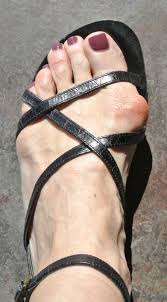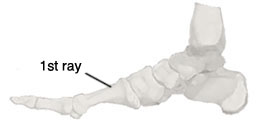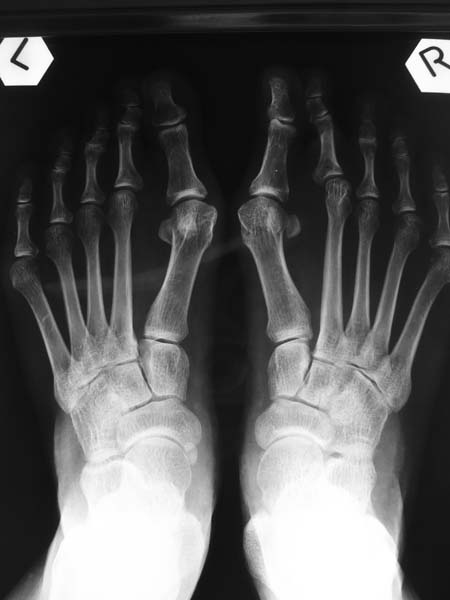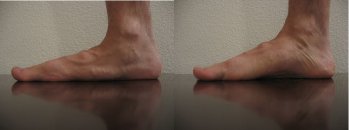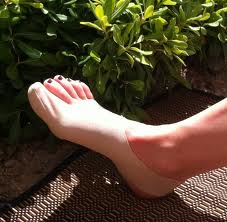
The Functional Impact of Bunions
When you hear the word “bunions”- what comes to mind?
Do you picture the foot of a young athlete or that of a stiletto-loving woman?
Often associated with high heels or blamed on “genetics”, bunions are actually more often due to improper biomechanics and faulty movement patterns.
In the below article we will explore the impact bunions have on functional movement – from the way we stabilize our core to the way we push off with each step!
To fully appreciate the functional impact of bunions, we must first understand both the biomechanics of the first ray as well as the fascial lines crossing the bottom of the foot.
The First Ray
The formation of bunions is associated with the stability (or rather instability) of the first ray and the balance of muscles around the 1st MPJ. The bones which make up the first ray include:
- medial cuneiform
- first metatarsal
- hallux (great toe)
When our foot loses stability of the 1st ray, specifically at the metatarsal / cuneiform joint, the long metatarsal is able to swing out medially forming the structure we recognize as bunions.
As the metatarsal / cuneiform joint deviates medially, the soft tissue structures around the 1st MPJ begin to deviate laterally.
What causes first ray instability?
If you guessed pronation or calcaneal eversion you are correct.
Some additional drivers of first ray instability include tibial:femoral external rotation or TFER. This was discussed in the blog post Subluxing Peroneals. In my office I find this TFER to be highly over-looked but one of the strongest drivers of bunion formation and foot dysfunction.
The First MPJ
To further understand the impact of bunions we must now explore the stability of the 1st MPJ or great toe joint.
Transverse plane stability of the 1st MPJ is a balance between the adductor hallucis muscle laterally and the abductor hallucis medially. What is unique about these two muscles is that they both share a tendon with another intrinsic muscle – the flexor hallucis brevis.
The flexor hallucis brevis muscle is unique in that it has two small sesamoid bones lying in the tendons.
If we take a closer look at the picture below we can appreciate how the medial tendon of the flexor hallucis brevis shares a tendon with the abductor hallucis, and the lateral tendon of the flexor hallucis brevis shares a tendon with the adductor hallucis.
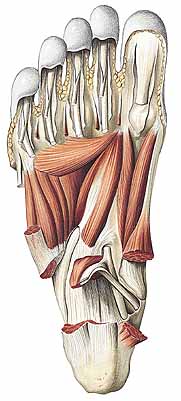
How 1st MPJ transverse plane stability impacts function has to do with what’s called sesamoid position. In the above picture we can see that the flexor hallucis brevis (and therefore sesamoids) are sitting directly under the 1st metatarsal head or 1st MPJ. This allows a perfect balance between the abductor and adductor hallucis.
If we go back to the bunion picture (below). We can appreciate that the sesamoids have shifted laterally away from the 1st metatarsal head.
How does this affect functional movement? The answer has to do with our fascial lines and how we stabilize proximally!
Foot Function and Fascial Lines
In the plantar foot the Deep Front Line (which is our deep stabilizing fascial line) consists of the deep posterior leg compartment including the posterior tibialis, flexor hallucis longus and flexor digitorum longus. For the purpose of this article we are going to focus on the posterior tibialis.
Running posterior to the medial malleolus and along the medial aspect of the foot, the Posterior Tibialis inserts onto the navicular. After attaching to the navicular the Posterior Tibialis fans out and has 9 osseous and fascial attachments which includes:
– every tarsal bone (except the talus)
– every metatarsal (except the 1st)
– peroneus longus tendon
– flexor hallucis brevis muscle
In EBFA education and programming we focus on how short foot specifically strengthens the intrinsic muscles of the foot and activates this stabilizing Deep Front Line.
Short Foot and the Deep Front Line
Short foot is a foot activation exercise that was first introduced by Janda et al.
This exercise targets the abductor hallucis on the medial side of the foot.
Because the abductor hallucis shares a tendon with the flexor hallucis brevis, and the flexor hallucis brevis has an attachment to posterior tibialis – we are able to tap into our Deep Front Line through short foot!
How bunions impact proximal stability has to do with the abductor hallucis and sesamoid position.
Remember we said in a bunion the sesamoids begin to shift laterally away from the head of the 1st metatarsal. As the sesamoids shift laterally they bring along the flexor hallucis brevis muscle (as well as the abductor hallucis!)
This lateral shift of the abductor hallucis pulls the muscle under the 1st metatarsal making it now a sagittal plane muscle (not a transverse plane muscle as it should be). It is this shift in the sesamoids driven by the bunion formation that impedes integrated proximal stability – from the ground up!
As we interfere with Deep Front Line stability, we subsequently interrupt Spiral Line and Lateral Line stability (since they are all integrated through the posterior tibialis muscle). All movement is integrated – integrated movement that starts with the foot!
So what can we do?
Short foot is one of the exercises I recommend to keep the foot strong and integrated with the core proximally. But what do we do if our clients have bunions and we cannot get them to activate the abductor hallucis through short foot?
I often talk about a product called Bunion Bootie. www.bunionbootie.com
This snazzy little product slips over the great toe and pulls it medially, allowing better engagement of short foot. By frequent use of Bunion Bootie – along with short foot exercises, your client will hopefully be able to restore foot to core integration.
Will this correct a bunion?
Not necessarily.
After a certain progression in bunion formation no bunion can be “cured” with exercises and/or toe stretchers. Since a bunion is actually an imbalance around the metatarsal / cuneiform joint or first ray – the only way to re-stabilize proper alignment is through surgery.
However, for those clients who never want surgery but want to remain functionally integrated with their foot – Bunion Bootie and short foot is your answer!
To learn more about the sesamoids, 1st MPJ and fascial lines please check out my other blog on Foot Function & Fascial Lines!
Are you barefoot strong?

